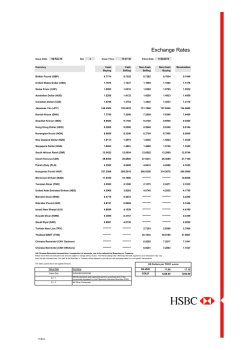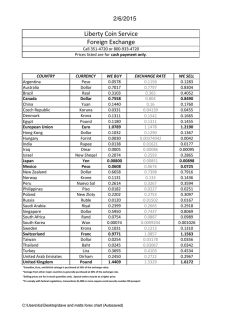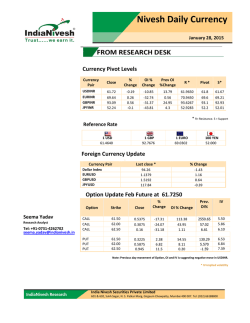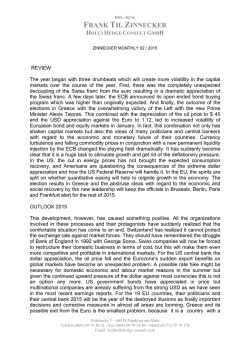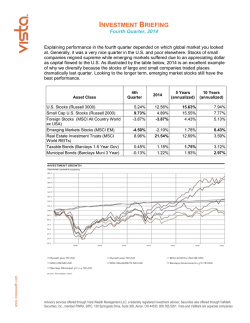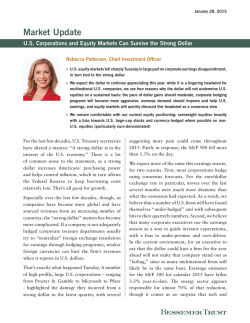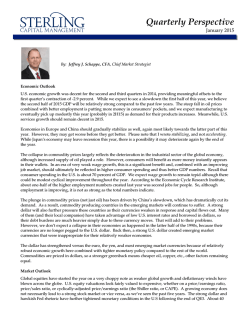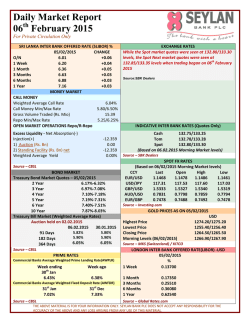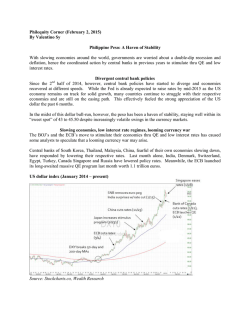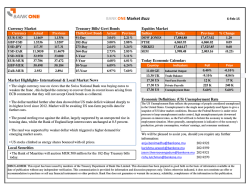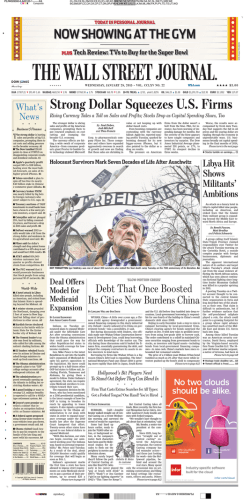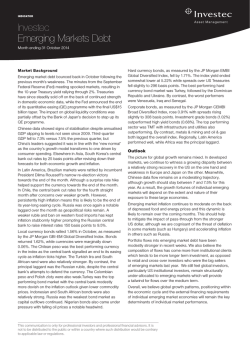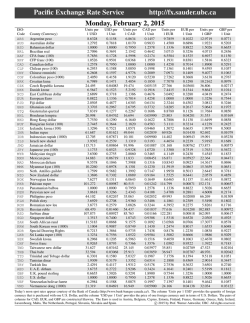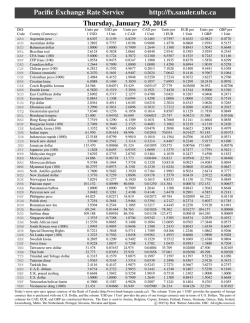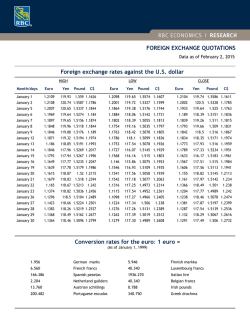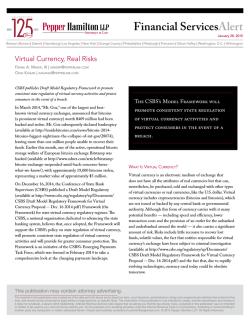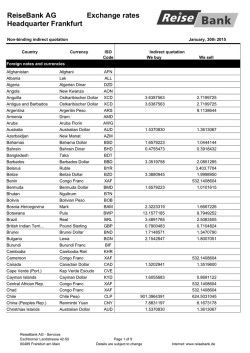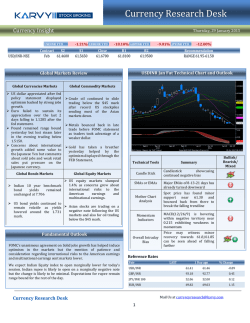
All major indicators are breaking down, deflation is taking
All major indicators are breaking down, deflation is taking hold and Wall Street is oblivious! The breakdown of the major indices for the economy is telling us something fundamental and what is Wall Street doing? They are just ignoring the signs on the wall, whilst the facts are right in their face, either because they don’t want to believe it or because they don’t know better. Lower oil prices and a much stronger US dollar are creating havoc in the energy and emerging debt markets $5trn in energy related corporate debt has been issued since 2009 and what do you think will happen to repayments with an oil price 50%+ below its 2014 levels. It is called bankruptcies! Why do you think the US dollar is so strong and thus the hard commodities so weak (inverse correlation)? Is it because the US economy is so strong? Some people believe the US economy is doing much better than the other major economies. Lets see what the effect of the tapering and the lay offs in the energy sector will be especially in the light of 9000 layoffs (Schlumberger) here 7000 layoffs (Halliburton) there etc. The oil states were the major hire states and that is reversing now. What do you think will happen to the trillions in emerging market dollar denominated debt with strongly devalued emerging market currencies (-‐10%+) and a US Dollar going through the roof!! The emerging markets have collectively borrowed $5.7 trillion in US dollars, a currency they cannot print and do not control. This hard-‐currency debt has tripled in a decade, split between $3.1 trillion in bank loans and $2.6 trillion in bonds. Much of the debt was taken out at low interest rates on the implicit assumption that the Fed would continue to flood the world with liquidity for years to come. The borrowers are “short dollars” and they now face the margin calls. The pledge to keep uber-‐stimulus for a “considerable time” has gone, and so has the market’s security blanket, or the Fed Put as it is called. Officials from the BIS say privately that developing countries may be just as vulnerable to a dollar shock as they were in the Fed tightening cycle of the late 1990s, which culminated in Russia’s default and the East Asia Crisis. The difference this time is that emerging markets have grown to be half the world economy and thus form a much bigger threat to the world economy and its financial system. Their aggregate debt levels have reached a record 175% of GDP, up 30 percentage points since 2009. Stress is spreading beyond Russia, Nigeria, Venezuela and other petro-‐states to the rest of the emerging market nexus, to countries such as Turkey, Brazil, Indonesia etc., as might be expected since this is a story of evaporating dollar liquidity as well as oil glut. The stronger the US boom, the worse it will be for those countries on the wrong side of the dollar. Deflation shows itself in much lower commodity prices The much lower price levels of the commodities that form the core of GDP growth in my point of view clearly demonstrates the deflationary forces (no demand) we are witnessing at present. Oil has fallen by more than 50%, copper has broken down the $3 level and is now going to $2.21 before it goes to its 2008 low of $1.25, iron ore is out of favor with prices falling to their lowest level since 2009 (TSI 62% fell to $63.3/t on Jan 27), lumber has broken down out of its triangle and the CRB index of course confirms this overall weakness being close to its 2009 low of 200 (see charts below). The lower demand for the vital commodities is also reflected in the level of the Baltic Dry Index, which is almost at its 2008 low of 663. Deflation also shows itself in ultra low and negative interest rates Deflation is a state of mind in my point of view characterized by a loss of confidence in future job security and job opportunities hence peoples reluctance to spend. And because of these reasons it is so difficult to turn deflation around with QE or any other measure. In my view one of these measures to fight the deflationary forces is bringing down interest rates to historic low and even negative interest rates in a desperate move to get the economies going. In general depending on the strength of the economy and current account surpluses the interest spread is driving the currency flows from lower interest countries to higher interest rates countries. The current account is an important indicator about an economy's health and thus its currency and therefore a determining factor in playing the interest spread or carry trades. The current account is defined as the sum of the balance of trade (goods and services exports less imports), net income from abroad (interest payments, dividends and other income) and net current transfers (capital transfers). Interest rates in some countries, Switzerland and Denmark, have even gone negative in a desperate act to discourage investors from buying their currencies in order to prevent their currencies from rising too much and stay competitive with regards to exports. The Danes said, ‘Well, we don’t want you coming into our currency. We’re going to cut rates.' Then the next day they cut rates some more — into negative territory. The Swiss cut it to minus 0.75%, letting everybody know they could take it to minus 1.5%. The Swiss don’t want you holding Swiss francs because it will make their export position more difficult and cause deflation because of lower import prices. And what about the Japanese? Kuroda in Davos said ‘Well, if we have deflation, we will have to do even more (money printing).' It’s going to force the Chinese to do the same in order to maintain market share. So countries are acting in their own interests. Anyway it is clear that with further deflationary pressure and more competitive currency devaluations, negative interest rates are spreading across a growing number of countries where (reported) inflationary prospects are minimal. Countries, such as Switzerland and Denmark, don’t have currency pools that are large enough in order to absorb the huge amounts of money that seek a safe haven from the competitive currency devaluations around the world. Flight from weak currencies is boosting the US dollar As a result of the weakness of many currencies, with the Yen and Euro being the main contributors, the US dollar, the reserve currency, is showing its strongest rally in at least 15 years climbing to 95.24. The USD index has risen by 19% from 80 to 95.24 since mid 2014 and in my opinion, looking at the point & figure chart here above, the road is now clear for the US dollar index to rise to 120! If you look at the 10y bund yield of 0.32% in combination with the Euro devaluation, following the Euro 1.1trn QE from March 2015 till September 2016, and a 10y treasury yield of 1.82% it would make sense that people sell their Euro bunds and buy treasuries further boosting the US dollar. This should force US interest rates further down to 1%-‐1.5% and thus make gold and silver even more attractive as a competitive asset class. The question is what will happen to the US dollar when this shift in funds flow is over! Will the US economy at that time be able to sustain the strong dollar, will the Chinese sell their US treasury holdings into strength in order to boost their Renminbi as the new reserve currency? Or will the US dollar implode in favor of the currencies of last resort: gold and silver? Anyway what are all these factors telling you? First of all these strong currency movements are far from normal and very disruptive as we have witnessed with the Swiss de-‐pegging their Swiss franc from the Euro. On January 14, the Swiss Franc was at its lowest level to the U.S. Dollar since September 2010 (0.98). As we know the next day, the Swiss National Bank made the surprise decision to unpeg the Franc to the Euro currency. Within 20 minutes, the Swiss Franc soared to 1.23 against the U.S. Dollar, its highest level since September 2011, which was around the time the SNB announced it would peg the Franc to the Euro. A 3% move is a lot for a currency to change even in a month. A 25% move in 20 minutes is surreal and a clear indication of the imbalances in the currency world. The word to best describe all these circumstances in my point of view is “desperado”. Next to that with deflation upon us monetary easing is doing the opposite of what it is supposed to do. The multiplier effect of monetary easing has clearly gone negative! The effect of the stimulus is negative instead of creating GDP growth. The big danger is that, even when economic activity turns down and prices are falling, the amount you owe doesn’t. Borrowers get crushed under the weight of that debt. In a mild scenario, companies and consumers hold back on other purchases to continue meeting their obligations. When things get really bad, they go bust altogether, which will also reflect itself on the currency hence why people flee to gold and silver to maintain their purchasing power. Policy makers usually have an antidote to economic slowdowns, but it’s trickier when interest rates are already near zero. Do you think that a difference in interest rates of lets say 0.5% or 1% will do the trick when there is no confidence? No, of course not. That’s exactly the situation with the ECB and much of the industrialized world. You can bring a horse to the water but you can’t make it drink and especially when the horse doesn’t trust the water. And more and more investors don’t believe the QE “magic” any longer hence why they are buying the only currency that can’t be diluted and manipulated: gold and silver. What I mean by that is that you can’t print gold whenever it suits you in order to manipulate the markets making people believe that economic circumstances are not as bad as they in reality are. Gold and silver are outperforming the US dollar! In 2014 gold had the strongest performance of all currencies after the US dollar. And since the beginning of the year the US dollar has risen by 4% from 91 to 94.63 whilst gold rose by 9.7% from $1,167 to $1,280 and silver by 16% from $15.51 to $18 despite the fact that the metals are inversely correlated to the US dollar. In other words they move in the opposite direction of the US dollar, which is the normal situation. The fact that gold and silver and the US dollar move in tandem means that gold and silver are in fact performing very strongly as is also proved by the fact that gold and silver have broken out in almost all currencies. See charts here below showing the gold price in Euros and Yen. Gold and silver are surfacing as the only stable, reliable and independent reference points for valuation and purchasing power and they are becoming again the spill of the financial system because all other yardsticks are failing because of dilution (QE)/manipulation and low or negative interest rates. They are taking over the role of interest rates that supposed to be the yardstick of valuation and risk of the different currencies. Watch the currency markets. They will be a key to understanding the price movements in other commodity markets, like gold and silver. Gold rallied above $1300 last week, for the first time since August 19, even as the Dollar was elevated to its highest mark in over 11 years. Gold rising with the Dollar rising? That just doesn’t happen unless…. the level of uncertainty (loss of faith, loss of credibility) in the financial world is rising too. What happens if the world loses its faith in the power that the central banks have assumed in managing world economies? Conclusion Concluding we are witnessing an increased intensity of deflationary pressures in Europe. A minus 0.75 per cent deposit rate makes cash look “attractive”. It also makes a case for gold. Whilst the yellow metal is often thought of as a hedge against inflation, it also is a hedge against central bank incompetence and monetary dysfunction, which includes deflation. There is no opportunity cost in holding gold when interest rates are below zero. And sure enough, the price of the precious metal has recently been creeping up. Gold is up significantly in four of the seven top currencies (the euro, British pound, Australian and Canadian dollars), up respectably in two others (U.S. dollar and Japanese yen) and down slightly in the Swiss franc. The significant recent gains in gold’s value demonstrate the value of gold as a hedge, not just against inflation, but against sudden currency devaluation and systemic financial and economic risks as well. Gold owners in these countries got the protection they sought against adverse circumstances. As long as the world maintains its trust in central banks to control economies, and as long as the central banks continue to devalue their nations’ currencies by creating more money and using it to purchase the debt of those nations, the more likely that stocks will keep rising. Although every time QE has been employed the positive effect for the markets seem to have worked out less and less. The marginal effect declined. The European Central Bank made its first attempt at quantitative easing. So now Europe is going to join Japan and follow the American playbook for an economic miracle. Keep on dreaming. The Japanese are failing to kick start their economy and so will the ECB and in the end they will only make things worse. How many times can you cry wolf and make consumers believe that it is going to work whilst it is not. I think we will see that the “positive” market effect from the European QE will wear off very quickly. Do you think that Draghi is turning around the psyche of the European consumers and makes them feel richer with stock markets and bond markets being fuelled by Euro 1.1trn whilst stock ownership is much lower in Europe than in the US next to that these measures also don’t trigger the same dynamic as in the US. In any case the financial markets are clearly feeling the effects of a pick-‐up in volatility that has followed the end of Fed QE with intraday swings in the Dow Jones index of between 400-‐ 600 points. While zero rates were augmented with Fed bond buying, investors went around the world in search of higher yields, in all sorts or assets and currencies. Traders and investors of one kind or another resorted to leverage to reach the yield targets they needed to match their required investment returns. All of which was fine while the party went on forever, but now that it’s ending, the outcome is anything but fine. It will not work; it is blowing up asset prices and not benefitting the consumers so that they will regain confidence and spend again. Deflation is a state of mind and stands for structural loss of confidence in my point of view. What the QE is doing is diluting the currencies and postponing the moment of truth. That cliff is appearing on the horizon no doubt, the second half of 2015 will be brutal that is BRUTAL!! Think the breakdown in the hard commodities, the very strong dollar and the effects on energy related and emerging market debt. Wall Street seems to take it all in a stride and still have this rock solid believe that the market will show another good year of growth. Anyway with further deflationary pressures and more competitive currency devaluations, negative interest rates will spread across a growing number of countries where inflationary prospects are minimal. Negative real interest rates (inflation higher than interest rates) favor gold because investors lose hardly any interest on bonds since they don’t yield any return. The growing number of investors who really understand the context of these depressing negative rates will ensure that gold will make a phenomenal comeback. Investors don’t want to hold diluted and manipulated currencies that lose their purchasing power they want currencies that can’t be diluted or manipulated, and can preserve their capital, they want physical gold and silver. Remember though that if you hold paper gold or silver i.e. a claim to delivery of physical gold and silver future or ETF) you run counter party risk, in other words you run the possibility that your counter party can’t fulfill its obligation to deliver you the physical gold when you ask him for it. © Gijsbert Groenewegen
© Copyright 2025
